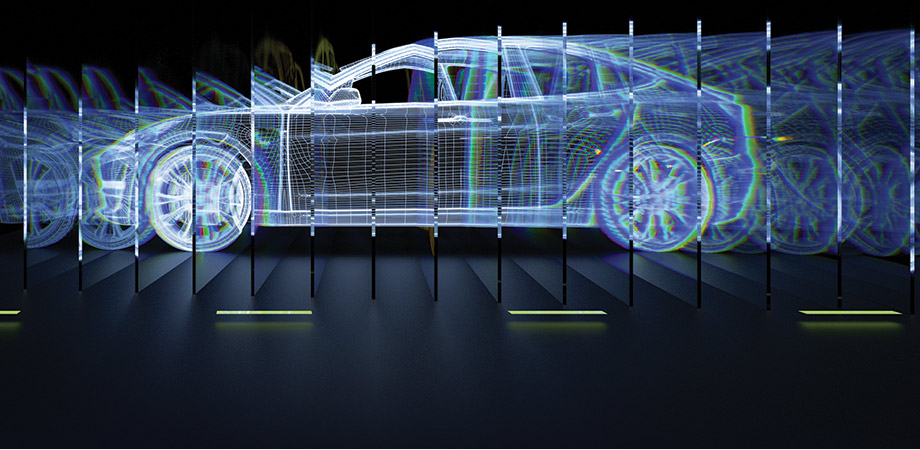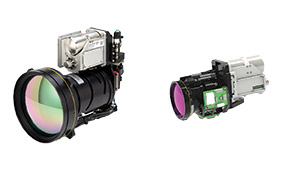Lidar: Lighting the path to vehicle autonomy

The DARPA grand challenge in the mid-2000s provided a catalyst for launching autonomous vehicles (AV). The original program goal was to develop technologies for military applications as part of the Future Combat Systems (FCS) initiative. While FCS stalled due to funding, politics, and execution challenges, the challenge spawned the talent and vision that would later drive efforts of companies like Google, General Motors, Ford, and others to launch initiatives for driverless cars. Today, many technology companies (Waymo, Nuro, Aurora, Argo, GM-Cruise, Nuro, Baidu, Alibaba, Plus, Gatik, Zoox, Embark, TuSimple, and Kodiak) are pursuing efforts for autonomous operation, including ride-hailing and trucking/logistics end markets. Vehicle autonomy has five levels (per five SAE definitions), with complete autonomy in a certain operational design domain (which includes roads, geography, weather, etc.) referred to as L4. L5, the highest level, implies complete and unconditional autonomy. While L5 is still far away (probably beyond 2030), L4 has become operational in limited geographies for trucking and ride-hailing.
Automotive original equipment manufacturers (OEMs) were initially paranoid about technology companies disrupting their business of selling cars to a high volume of consumers rather than a more limited customer base of ride-sharing service providers. Early on they invested in L4/L5 efforts but are now more focused on advanced driver assistance systems (ADAS) and L3, which is conditional autonomy: hands-off, feet-off, and eyes-off as long as the vehicle computer decides conditions are appropriate for such operation, with the human driver being ready to take control in <10 seconds if conditions warrant. Tesla is an exception to the focus on L3—they are bullishly predicting, as they have done for the past three years, that full autonomy (unclear whether L4 or L5) is imminent. Teslaratis are very loyal and patient!
Apart from the autonomy revolution, the DARPA Grand Challenge also unleashed significant innovations in sensing and artificial intelligence. David Hall of Velodyne, which made high-end speakers and sound systems in the early 2000s, innovated and developed what would later be called the "surround view lidar," where the arrays of lasers and detectors rotated 360° to provide a complete 3D image of the environment around the car. This proved to be an incredibly ingenious innovation and was used by multiple competitors in the DARPA Grand Challenge. Over time, lidar has become a critical third sensing modality, in addition to more mature radar and camera technologies, for providing situational awareness, localization, mapping, and obstacle avoidance capabilities for autonomous cars.
Most players in the autonomy space rely on lidar today, though Tesla is, again, an exception. For some companies, this is a critical enough technology to warrant captive control and internal development: Waymo, Aurora, Argo, GM-Cruise, and Intel-Mobileye are examples of autonomy-platform players with internal lidar development efforts.
The consumer electronics space has also been active in promoting lidar capability in products. Apple launched lidar-equipped iPads and the iPhone 12 in 2020, allowing consumers to experience its impact in a personal way, and increasing acceptance as it transitions into safety applications for ADAS and autonomy.
Automotive lidar investments and approaches
Since 2013, ~$2B of venture funding has gone into approximately 80 different startups pursuing different technology avenues for realizing an automotive performance lidar. Additional investments have gone into captive lidar developments by autonomous vehicle technology players, as well as automotive Tier 1 companies like ZF, Valeo, and Continental. High-profile lidar IP lawsuits have occurred—the most well-known was a gripping soap-opera-like legal battle between Uber and Google in the 2017–2019 timeframe.
The venture-investment frenzy is due to the somewhat inflated and aggressive business projections for autonomous ride-hailing and transportation as a service (TaaS), and the opportunities created for lidar. The investments are contributing to what appears to be a bubble, reminiscent of the fiber-optics investment frenzy for communications at the turn of the century.
Table 1 explains how the roughly 80 lidar companies are pursuing different designs based on combinations of wavelength, field-of-view (FoV) scanning approaches, and the physical principle used (time of flight, or ToF, with linear detectors, ToF with photon counting detectors, and frequency modulated continuous wave, or FMCW).

Table 1 Different design approaches for automotive lidar. The numbers refer to total companies in a cell; captive companies are not reliant on external funding, because they are Tier 1 suppliers themselves, or within a larger AV technology company. ©Patience Consulting LLC (Reproduced from bit.ly/iPhoneLIDAR)
A large percentage of companies belong to cell 1. A big reason is that the material systems used for lasers (GaAs) and detectors (silicon) at the 8xx–9xx nm wavelengths are highly industrialized, inexpensive, temperature invariant, and mature. Scanning enables the use of single or linear array elements of lasers and detectors, which are readily available. The Apple lidar uses an architecture like that in cell 7—flash, global shutter, vertical cavity surface emitting lasers (VCSELs), and single-photon avalanche diodes (SPADs), although the performance is much more limited than for an automotive safety application. As SPAD technology matures, companies in cells 4 and 7 become extremely attractive from a performance, power, and size perspective.
Despite the many advantages, the 8xx–9xx nm wavelengths are less eye safe than 14xx/15xx nm systems. As a result, they have lagged in terms of range and resolution performance, although significant disruptions are occurring in this regard, especially those using ToF with photon counting.
The situation for the 14xx–15xx nm wavelengths is different (cells 3, 6, and 2). Fewer companies are competing in this space, primarily because the laser and detector technologies are not as readily available, and optical-device-level expertise is required to create a system solution. This is also a more expensive material system (InP lasers and detectors) due to lower yields, processing immaturity, and smaller wafer sizes. Temperature stabilization of lasers and detectors is required. No flash solutions exist in this wavelength-the expensive material systems used for the laser and detector demand that resources be shared (in time and space) via scanning (typically mechanical today). The higher eye safety margins afforded at this wavelength enable better range and resolution performance. Finally, FMCW lidar companies exist at the 14xx–15xx wavelengths (cell 2). These lidars have some key advantages over ToF lidars—simultaneous velocity and range sensing, higher immunity to solar and cross-lidar interference, and the potential to use optical phased arrays for nonmechanical scanning. This approach, however, is still highly immature and not likely to occur anytime soon.
In the end, not all companies will survive as standalone entities to serve the transportation market. Some will, or already have, pivoted into other applications, such as security, industrial robotics, construction, and mining; others will either go bankrupt, merge with competitors, or get acquired by larger companies. Over the past six months, a total of five companies have announced mergers with special purpose acquisition companies (SPACs). Two have consummated these mergers (Velodyne in 1 and Luminar in 3), and three announced intentions to do so (Ouster in 4, Aeva in 2, and Innoviz in 1).
The reason for the acceleration of SPAC mergers is simple—the applications and opportunities are becoming real; it is expensive to industrialize the technology for automotive deployment; and venture funds are losing their appetite for further risky investments and would rather monetize their investments before the boom period ends.
The five recent SPAC mergers have created market capitalization of ~$20B, with about $1.5B going back to these companies to fund their industrialization efforts. This translates to about a tenfold return for investors, including about $1B invested in these companies in prior investment rounds. Not bad for five years of work and risks! Optics is, indeed, an exciting business.
Market size
The automotive market presents significant opportunities for lidar and the optical supply chain. According to US Securities and Exchange Commission filings by the five companies involved in the mergers listed above, total 2025 automotive lidar revenues for these companies are estimated at $3B for 3M units, including hardware and software revenues, suggesting an average price of $1000/unit. This is across L3 ADAS and L4/L5 AV applications for ride-hailing cars and autonomous trucks.
The total available market (TAM) for automotive lidar suggested by these companies is on average $40B in 2025 (though there are large variations across the companies), and projected to increase by threefold in 2030. More conservative estimates and averaging views from multiple proprietary financial analyst reports suggest a $10.6B lidar TAM in 2025, increasing to $31B in 2030. The TAM comparisons for the two different sources are provided in Table 2.

Table 2 TAM Comparisons. ©Patience Consulting LLC
In the averaged industry reports and analysis, the 2025 TAM of $10.6B assumes 8M L3/L4 cars and 57,000 L4 trucks, implying a lidar content on an average of about $1.3K/vehicle. The 2030 TAM of $31B is based on 21M L3/L4 cars and 4M L4 trucks, with average lidar content of $1.4K/vehicle. The reason the lidar content/vehicle does not reduce with volume is the higher number of L4 trucks and cars, which consume significantly higher lidar content than L3 (which dominates the volume and revenues in 2025). These estimates are based on projections of TaaS revenues, prices for L3/L4/L5 features, and an affordable price point for lidar content per vehicle in order to support the overall autonomy services business case.
The good news in all this is that the SPAC-capitalized companies project acquiring 30 percent of the TAM ($3B of the $10.6B) in 2025—a $6.4B opportunity still awaits other companies to capitalize on. If the SPAC company TAM projections are correct, then there is even more gold to be mined. But mining the gold is going to require more money—and that is the most critical challenge facing standalone lidar companies.
It is also worth noting that the original goal of the DARPA Grand Challenge, which was to promote military vehicle autonomy, is gaining new life in recent programs like the optionally manned fighting vehicle and robotic combat vehicle. This presents excellent opportunities for lidar companies to leverage their technology, attract new sources of funding, and present potential acquisition opportunities.
The future for lidar in the transportation business
Just like cameras, lidar is poised to occupy an important place in the future of ADAS and AVs as the revolution in movement automation progresses. The winners will be the ones who recognize that the exciting period of inflated expectations in the Gartner Hype Cycle is nearing the end, and the business is entering a more "boring" period that demands productivity and execution. Making sure that lidar companies are well funded is now critical. Unfortunately, funding is a circular problem—it requires customer traction, which in turn demands evidence that the company is well funded.
The companies that succeed will be those with enough funding, performance differentiation, customer penetration, and supplier/manufacturing relationships. The key is to have the right combination of product timing, performance, pricing, scalability, and reliability. Automotive lidar is a brutal but exciting business, and there will be big winners, just like there were in the fiber optics boom-and-bust period 20 years ago.
Sabbir Rangwala led the automotive lidar business at Princeton Lightwave until 2017. His company Patience Consulting provides expertise on AVs, perception, and lidar.
| Enjoy this article? Get similar news in your inbox |
|



